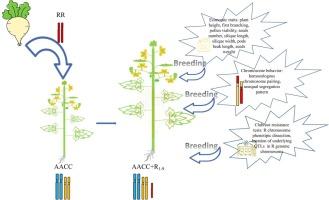在天然甘蓝型油菜上系统培育一套完整的油菜单体外源附加系及抗棒根病育种检测
IF 6.2
1区 农林科学
Q1 AGRICULTURAL ENGINEERING
引用次数: 0
摘要
甘蓝型油菜是重要的油料作物,生物量大,产量可观。然而,农业历史短,遗传资源有限,易受多种生物和非生物胁迫,使得甘蓝型油菜的改良迫在眉睫。通过种间杂交产生的单体外源附加系(MAALs)有望成为将野生物种的有利性状转移到作物上的宝贵遗传资源,已成为许多研究者的研究热点。本文通过对合成的异源倍体(AACCBBRR, 2 n = 72)与油菜单倍体进行回交筛选,获得了一套完整的油菜单倍体-萝卜单倍体MAALs (aaccr1 - 9,2 n = 39)。“优言”(AACC, 2 n = 38)用一组R染色体特异性引物进行PCR扩增和多色荧光原位杂交。这些MAALs表现出广泛的形态变异,导致了许多理想的农艺性状,包括每角果种子数多、角果长且宽、荚果喙长和种子重,这些性状可用于甘蓝型油菜的进一步改良。异体R染色体通过雄性配子的传输率普遍高于雌性配子,并且在MAALs中广泛存在同源交换(HE)现象,包括C基因组与R染色体之间的同源染色体配对偏差,同源染色体配对频率(HEP)在26.73 % (AACCR6)至91.96 % (AACCR7)之间。双FISH还观察到后期I的三种不平等分离模式(20:19,21:18,23:16)。另外,对棍棒病抗性试验显示AACCR5对十字花科疟原虫病原菌具有抗性,另外2个品系(AACCR7和AACCR9)对棍棒病可能有少量抗性基因。综上所述,这些MAALs对于提高甘蓝型油菜的遗传多样性和创新优良种质资源具有重要意义。本文章由计算机程序翻译,如有差异,请以英文原文为准。

Systemic development of a complete set of monosomic alien addition lines of Raphanus sativus in natural Brassica napus and detection in breeding for clubroot resistance
Brassica napus, as an important oil crop, boasts great biomass and considerable yield. Nonetheless, short agricultural history, limited genetic resources and susceptible to a multitude of biotic and abiotic stressors make the improvement of B. napus an urgent task. Monosomic alien addition lines (MAALs) created by interspecific hybridization have become a great pursuit for many researchers, because they are expected to be valuable genetic stocks to transfer favorable traits from wild species to crops. Herein, a complete set of B. napus-Raphanus sativus (radish) MAALs (AACCR1–9, 2 n = 39) was developed after screening thousands of backcrossing individuals between the synthesized allootacploid (AACCBBRR, 2 n = 72) and B. napus cv. “Youyan” (AACC, 2 n = 38) using PCR amplification with a set of R chromosome specific primers and multi-color fluorescence in situ hybridization. These MAALs exhibit a wide range of morphological variations, which have resulted in many desirable agronomic traits, including more seeds per silique, longer and wider silique, longer pod beak and heavier seeds weight, which can be used for further improvement of Brassica napus. A higher transmission rate of alien R chromosome via male gamete than female gamete was generally observed in MAALs, and a widespread homoeologous exchange (HE), including a bias of homoeologous chromosome pairing between C genome and R chromosome, was detected in the MAALs with the frequency of homoeologous chromosome pairing (HEP) ranging from 26.73 % (AACCR6) to 91.96 % (AACCR7). Three unequal segregation patterns (20:19, 21:18, 23:16) in anaphase I were also observed using dual FISH. In addition, the clubroot resistance tests revealed that AACCR5 was resistant to Plasmodiophora brassicae pathotypes and other two lines (AACCR7 and AACCR9) may have minor gene resistant to the clubroot disease. Overall, these MAALs are pivotal for enhancing the genetic diversity and for the innovation of excellent germplasm resources for genetic improvement of B. napus.
求助全文
通过发布文献求助,成功后即可免费获取论文全文。
去求助
来源期刊

Industrial Crops and Products
农林科学-农业工程
CiteScore
9.50
自引率
8.50%
发文量
1518
审稿时长
43 days
期刊介绍:
Industrial Crops and Products is an International Journal publishing academic and industrial research on industrial (defined as non-food/non-feed) crops and products. Papers concern both crop-oriented and bio-based materials from crops-oriented research, and should be of interest to an international audience, hypothesis driven, and where comparisons are made statistics performed.
 求助内容:
求助内容: 应助结果提醒方式:
应助结果提醒方式:


